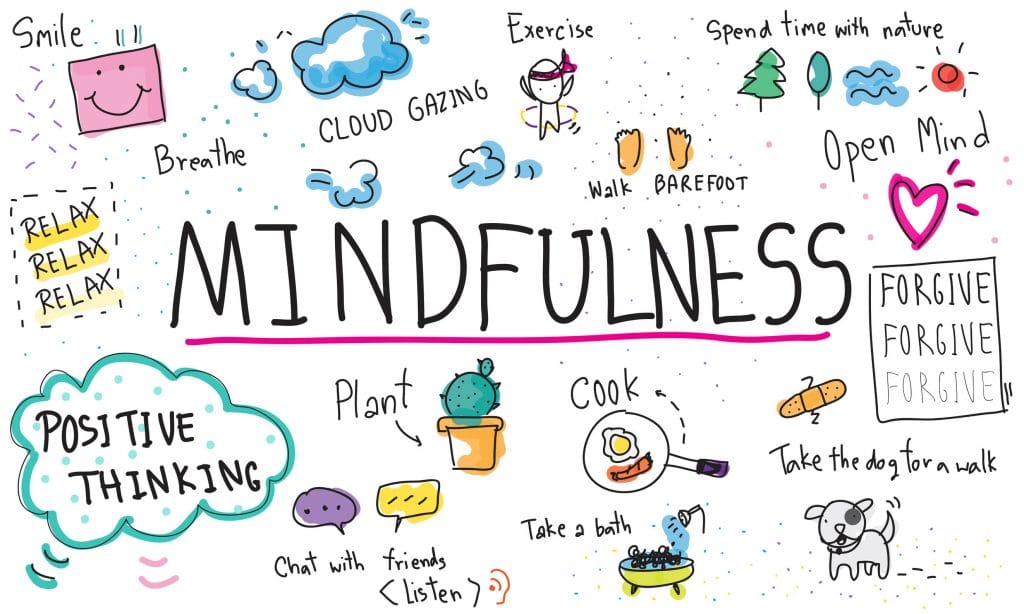Mindfulness is paying attention to the present moment with curiosity and non-judgement. To be fully present and aware of where we are, what we are doing and not overreacting or being overwhelmed by what is happening around us.
This practice is newer to the west but has been around for 1,000’s of years in other parts of the world, because it works. It’s increasingly becoming more relevant as our lifestyles keep getting faster and more complex. It is a gentle, but radical response to the complex and stressful activity in our lives and can have a profound effect on our health and well-being by increasing our inner peace.
Often, our mind takes flight, we lose touch with our body, and pretty soon we’re engrossed in obsessive thoughts about something that just happened or worrying about the future, with very little attention to what is happening in the present and this causes anxiety for many of us.
The “radical acceptance” of thoughts and feelings (instead of trying to escape them) gives us tremendous freedom and power to learn and grow from challenging situations. We begin to acknowledge it’s a part of the human condition and we are not alone.

The Basics of Mindfulness
Mindfulness is a basic ability that every human being already possesses, you just have to learn how to access it. The following are four basic premises.
ATTENTION: Listening or watching by directing attention to a selected object, sound, breath, etc.
INTENTION: Purposefully increasing awareness of experience.
PRESENCE: Being in the moment, here and now.
OPENNESS: Being curious, objective, and non-judgmental about the experience.
You create space for your thoughts and feelings and observe them. Sit with them and experience them, while breathing deeply to help your mind and body calm. Instead of distracting yourself or running from it, you start to understand what the root issue of the feeling is, gain insight, and start to heal.
This is not the same as being resigned, passive or hopeless.
It’s simply observing and accepting. Denying a negative mindset is destructive to your mental health. Suppressed emotions will always resurface in some mental or physical issue; pain, suffering, or illness.
If you consistently resist an uncomfortable feeling it can gradually grow until it becomes a habit (like background noise) and becomes detrimental to your mental or physical health. Learning how to relate to the experiences differently is key.
Most of us have a negative internal dialogue that comments on our feelings, thoughts, or actions in a critical and judging manner, sometimes even with disdain or shaming.
The Most Important Part Of the Practice Is Your Approach
Strive to be accepting, compassionate, curious, and non-judging as you observe your thoughts, emotions, and behavior.
Creating space and observing your thoughts, feelings, and physical sensations helps you identify with them and makes it easier to not let them take you over.
You may not be able to change the situation you are in, but you can change your response to it.
The Benefits of Routine Mindfulness Practice
- Calms your nervous system
- Boosts the immune system
- Decreases chronic pain
- Improves cognitive performance
- Increased focus and attention
- Decreases stress levels and anxiety
- Increases emotional well being and self compassion
- Healthier responses to difficult social situations
- Increased compassion for others
Mindfulness is the first step in emotional healing. You develop the skill to be able to process your feelings better when you turn toward and acknowledge your difficult thoughts and feelings (sadness, anger, insecurity, anxiety) with an open and curious approach. Research has shown that this act of self-love and self-compassion greatly enhances your emotional wellbeing.
We can be strong enough to meet the challenges and comfort ourselves when we need to. Cultivating self-love and self-compassion is a profound and powerful way to deal with life challenges.
Examples of the Best Mindfulness Exercises for Beginners
Naming a Thought or Emotion
Give your thoughts/feelings a name like Amy or Alice for anxiety or Billy (the bully) for a self-critical or judging thought. Making it more playful takes the seriousness out of it.
Watch how to practice this mindfulness exercise below:
Is That Really True?
Questioning a thought and then confronting and telling it is not true. Most of the time we believe every thought that comes in our head and most of them are simply not true.
Watch how to practice this mindfulness exercise below:
Objects in Nature
Get out into nature and sit and listen for 2-5 minutes to all the sounds you hear (birds, animals, water, breeze, trees, etc.). Try to pick them out and notice how long you hear them.
Watch how to practice this mindfulness exercise below:
When you practice these mindful exercises, you train your brain to focus in a meditative state. This training gives you more control over your thought processes later when you are trying to change your thinking patterns.
You learn that your thoughts are not who you are. You stop identifying with them and learn to observe them. It also trains you to be more present, which calms your mind and body and boosts your immune system.
The aim should never be to suppress your thoughts. Instead, the aim is to simply notice thoughts arising or notice that your attention has been drawn to them. Then, without judgment, return to your initial goal, to focus on something.
Mindfulness isn’t about becoming good at sitting on a meditation cushion and doing some exercises. It’s learning new ways of sensing, understanding, and responding to everything in their lives. It is a practice that recognizes and cultivates the best of who we are as human beings.

